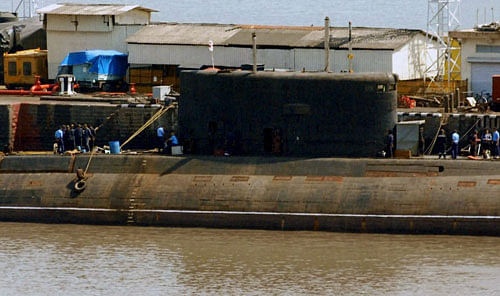
A week after the fire mishap on-board INS Sindhuratna off Mumbai, the Navy has categorically ruled out battery being the source of the fire and smoke that killed two young Navy officers and injured seven sailors.
“The battery pit is completely safe without any damage. A two star officer has inspected it and submitted his report to the naval headquarters. The fire took place in the sailor's accommodation,” a Navy officer said here on Monday.
The battery was taken from another Kilo class submarine INS Sindhukesari and almost 40 per cent life of the battery was intact when it was fitted into INS Sindhuratna. Among the oldest in the Navy’s Kilo-class submarine fleet, the two submarines were commissioned in 1988 and 1989.
An 1 metre long stretch of cable on the starboard side of the boat was gutted in the submarine's third compartment that houses the galley at the top, sailor's accommodation in the middle and the battery pit at the bottom.
The sailor's accommodation where the fire had begun contained inflammable material like clothes, paper and
mobile phones. The source of the fire remained unknown and required further investigation.
The two officers are believed to have closed the hatch to isolate the compartment from the rest of the submarine and likely to be choked to death because of the smoke and fire-extinguishing gas that sucks out oxygen from the compartment. The accident occurred when the submarine was under water about 80 km from Mumbai coast.
The 75 metre long submarine had two battery pits, each comprising 120 batteries. Each of these 120 battery weighs 850 kg.
No damage was found in any of these pits, officials said ruling out fire triggered by an outdated battery. Defence Ministry sources said the defence acquisition council in November, 2013, approved purchase of new batteries for Navy's ageing submarine fleet.
The 10 Russian origin Kilo-class submarines were purchased between 1986 and 2000, whereas the four German HDW submarines were procured between 1986 and 1994.
Because of the depleting strength of its underwater arm, the Navy now plans to upgrade six submarines, four Kilo-class and two HDW.
Following the August 14 explosion on INS Sindhurakshak that killed 18 personnel, the Navy overhauled its safety protocols. The new protocol includes audit of the standard operating procedures on all operational submarines and safety audits of ships and submarine before operational deployment.
Deccan Herald is on WhatsApp Channels| Join now for Breaking News & Editor's Picks